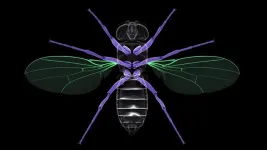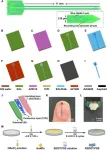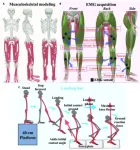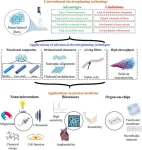(Press-News.org) Work is underway on a wiring diagram of the motor circuits in the central nervous system that control muscles in fruit flies. This connectome, as the wiring diagram is called, is already providing detailed information on how the nerve coordination of leg movements differs from that controlling the wings.
Although fruit flies seem like simple creatures, the researchers said that their motor system contains “an unexpected level of complexity.”
“A typical fly motor neuron receives thousands of synapses from hundreds of presynaptic premotor neurons,” the scientists observed. “This number is on par with the scale of synaptic integration in pyramidal cells of the rodent cortex.”
Some of the latest findings in this area are published in two papers June 26 in the scientific journal Nature. They are titled “Synaptic architecture of leg and wing premotor control networks in Drosophila” and “Connectomic reconstruction of a female Drosophila ventral nerve cord.”
The senior scientists jointly supervising the research were John C. Tuthill, associate professor of physiology and biophysics at the University of Washington School of Medicine in Seattle, and Wei-Chung Allen Lee, associate professor of neurology at Harvard Medical School in Boston. A multi-institutional group of scientists contributed to the studies.
This research advances the understanding of how the central nervous system in animals coordinates individual muscles to carry out a variety of behaviors. A fruit fly uses its legs, for example, in leaping, walking, grooming, fighting and courtship. It can also adapt its gait to navigate terrains like house plants, walls, damp surfaces, ceilings – and even insect-scale treadmills.
All such movements, from postural reflexes that enable a fly to hold its position steady, to traversing obstacles or changing flight direction, originate through electrical signals from motor neurons. These signals are conducted through threadlike projections from the motor neuron to stimulate muscles.
A fly’s six legs are managed by just 60 to 70 motor neurons, the researchers pointed out. In a cat, they noted, about 600 motor neurons supply a single feline calf muscle. Only 29 motor neurons govern the power and steering muscles of a fruit fly wing. In comparison, a hummingbird’s pectoral muscle is supplied by 2,000 motor neurons.
Although the fly’s motor neurons are few, it performs remarkable aerial and terrestrial feats.
The scientists explained that motor units are composed of a single motor neuron and the muscle fibers that it can excite. Various motor units, activated in different combinations and sequences, collaborate to achieve a myriad of movement behaviors.
The scientists in the two studies were interested in the wiring logic of premotor circuits. They wanted to understand how a fly’s nervous system coordinates motor units to accomplish varied tasks.
One of the studies employed automated tools, machine learning, cell-type annotation, and electron microscopy to identify 14,600 neuronal cell bodies and about 45 million synapses (signal-transmission junctions) in the ventral nerve cord of a female fruit fly. The ventral nerve cord in flies is analogous to the spinal cord in vertebrates. They scientists went on to apply deep learning to automatically reconstruct the anatomy of the neurons and their connections throughout the female fly.
Then the researchers used sophisticated methods to map the muscles targeted by leg and wing motor neurons. They determined which motor neurons in female adult nerve cord connectome connect to individual muscles in the front leg and wing. From there, they created an atlas of the circuits that coordinate the fly’s leg and wing movements during take-off and flight motor initiation.
To get into the air, the fly’s middle legs extend to jump and its front legs flex for departure. This is very roughly like a taxiing airliner retracting its wheels after leaving the ground or a wading heron tucking its spindly legs to keep them out of the way as it rushes into the sky.
As part of their work, the scientists also found that some muscle fibers in adult flies are innervated by several motor neurons. This also occurs in the larval stage of the fruit fly and in locusts. While some mammals have multiple innervations of nerve fibers as newborns, these usually disappear by adulthood.
Multiple innervations might offer more flexibility and explain why an insects’ limbs can operate with precision despite having so few motor neurons.
The scientists also examined the fly’s wing motor system, which has roughly three sections grouped by function: powering the wing flapping, steering the insect, and adjusting wing motion.
The investigation of the connectivity of the premotor neurons enabled the researchers to compare the organization of premotor circuits for two types of limbs. The leg and the wing in fruit flies each have a distinct evolution and biomechanics.
More generally, connectomes are allowing scientists to produce new theories on how neural circuits function, and to debunk some false notions. The scientists mentioned that the recent community effort to develop the fruit fly connectome has led to one of the first synapse-level wiring diagrams for any limbed animal. They hope that additional connectomes will allow researchers to compare neural wiring across individuals. The anticipated reconstruction of a male fruit fly central nerve cord might illuminate differences between sexes.
The research was supported by a Searle Scholar Award, Klingenstein-Simons Fellowship, Pew Biomedical Scholar Award, McKnight Scholar Award, Sloan Research Fellowship, New York Stem Cell Foundation, University of Washington Innovation Award, Genise Goldenson Award, National Institutes of Health Grants U19NS104655, RO1MH177808.
END
From takeoff to flight, the wiring of a fly's nervous system is mapped
Scientists explore the circuitry controlling leg and wing movements that propel fruit flies into the air
2024-06-26
ELSE PRESS RELEASES FROM THIS DATE:
A chip-scale Titanium-sapphire laser
2024-06-26
As lasers go, those made of Titanium-sapphire (Ti:sapphire) are considered to have “unmatched” performance. They are indispensable in many fields, including cutting-edge quantum optics, spectroscopy, and neuroscience. But that performance comes at a steep price. Ti:sapphire lasers are big, on the order of cubic feet in volume. They are expensive, costing hundreds of thousands of dollars each. And they require other high-powered lasers, themselves costing $30,000 each, to supply them with enough energy to function.
As a result, Ti:sapphire lasers ...
El Niño forecasts extended to 18 months with innovative physics-based model
2024-06-26
Across Asia, the Pacific Ocean, and the Americas, El Niño Southern Oscillation (ENSO) brings variations in winds, weather, and ocean temperature that can cause droughts, floods, crop failures, and food shortages. Recently, the world has experienced a major El Niño event in 2023-2024, dramatically impacting weather, climate, ecosystems, and economies globally. By developing an innovative modeling approach, researchers from the School of Ocean and Earth Science and Technology (SOEST) at the University ...
Scientists discover genetic ‘off switch’ in legume plants that limits biological ability to source nutrients
2024-06-26
A genetic “off switch” that shuts down the process in which legume plants convert atmospheric nitrogen into nutrients has been identified for the first time by a team of international scientists.
Legumes like beans, peas and lentils are unique among crops for their ability to interact with soil bacteria to convert or “fix” nitrogen into a usable form of nutrients. However, this energy-intensive biological process is reduced when nitrogen is already abundant in the soil either through natural processes or through the application of synthetic ...
The Frontiers Planet Prize announces 2024 International Champions
2024-06-26
The Frontiers Planet Prize today (26 June) announced its 2024 International Champions. The Prize recognizes and rewards scientists whose groundbreaking research accelerates solutions to help humanity remain safely within the nine planetary boundaries. The three winning scientists, Dr Pedro Jaureguiberry, Instituto Multidisciplinario de Biología Vegetal (Argentina), Prof Dr Peter Haase, Senckenberg Society for Nature Research (Germany), and Prof Jason Rohr, University of Notre Dame (USA), were each awarded 1.1 million (USD) / 1 million (CHF) to support their research.
The International Champions award-winning research ...
Precision instrument bolsters efforts to find elusive dark energy
2024-06-26
Dark energy — a mysterious force pushing the universe apart at an ever-increasing rate — was discovered 26 years ago, and ever since, scientists have been searching for a new and exotic particle causing the expansion.
Pushing the boundaries of this search, University of California, Berkeley physicists have now built the most precise experiment yet to look for minor deviations from the accepted theory of gravity that could be evidence for such a particle, which theorists have dubbed a chameleon or symmetron.
The experiment, which combines an atom interferometer for precise gravity ...
Overcoming challenges encountered by Spanish-speaking trauma patients
2024-06-26
Key Takeaways
Spanish-speaking patients who suffer traumatic injuries face gaps in their care once they leave the hospital, many with a high need for mental health services.
More than half of the patients studied reported food insecurity, transportation challenges, and needing help with utilities.
A novel care pathway developed by researchers can help connect these patients with needed services.
CHICAGO – Many trauma patients face a myriad of challenges when recovering from a traumatic injury, ...
Every walk you take: Promoting active and healthy ageing of citizens
2024-06-26
Promoting active and healthy ageing of citizens through a new mobile application that shows walking routes through green areas in Barcelona with data on geolocation, obstacles, pollution and weather in real time: this is the aim of the citizen science project Every Walk You Take, promoted by a team from the University of Barcelona. This initiative aims to promote physical activity and health among the over-fifty-five population through a new mobile-assisted health intervention (mHealth).
This innovative app, presented in an article published in Sustainability ...
Innovative research unveils link between depression and amygdala activity in rats
2024-06-26
A significant new study published in the Cyborg Bionic Systems journal by Fanli Kong and colleagues sheds light on the intricate relationship between depression and brain activity, particularly focusing on the basolateral amygdala (BLA) in rats. This research offers compelling insights into how depression can alter neural circuits and could pave the way for new treatments.
Depression is a debilitating mental health issue affecting millions worldwide and is known for symptoms like persistent sadness, loss of interest in enjoyable activities, and fatigue. While traditional treatments have focused on neurotransmitters in the brain, this study dives deeper into the brain’s structural ...
Navigating the fine line between performance and safety in sports: Insights from landing mechanics research
2024-06-26
The recent study by Datao Xu and his team at Ningbo University has unveiled important strategies that can be applied in athletic training and rehabilitation to curb the high rates of lower limb injuries. Their research meticulously analyzes the mechanics of single-leg landings—a common move in various sports—to propose enhanced landing techniques that not only aim to protect athletes but also improve their performance by enabling quicker recovery and continuation in sports activities.
One of the study’s most significant contributions is its detailed exploration of the role of ankle dynamics in absorbing landing impacts. ...
Innovative electrospinning techniques revolutionize precise medicine through advanced medical devices
2024-06-26
In a groundbreaking advancement that could reshape the landscape of precise medicine, researchers from the Beijing Institute of Technology and Rutgers University have unveiled a series of innovative electrospinning techniques capable of significantly enhancing the functionality and effectiveness of medical devices. This pioneering study, recently published in the Cyborg Bionic Systems journal, promises to revolutionize the creation and implementation of nano/microrobots, wearable/implantable biosensors, and organ-on-chip systems.
Precise medicine, aimed at tailoring healthcare to individual patients ...
LAST 30 PRESS RELEASES:
How talking slows eye movements behind the wheel
The Ceramic Society of Japan’s Oxoate Ceramics Research Association launches new international book project
Heart-brain connection: international study reveals the role of the vagus nerve in keeping the heart young
Researchers identify Rb1 as a predictive biomarker for a new therapeutic strategy in some breast cancers
Survey reveals ethical gaps slowing AI adoption in pediatric surgery
Stimulant ADHD medications work differently than thought
AI overestimates how smart people are, according to HSE economists
HSE researchers create genome-wide map of quadruplexes
Scientists boost cell "powerhouses" to burn more calories
Automatic label checking: The missing step in making reliable medical AI
Low daily alcohol intake linked to 50% heightened mouth cancer risk in India
American Meteorological Society announces Rick Spinrad as 2026 President-Elect
Biomass-based carbon capture spotlighted in newly released global climate webinar recording
Illuminating invisible nano pollutants: advanced bioimaging tracks the full journey of emerging nanoscale contaminants in living systems
How does age affect recovery from spinal cord injury?
Novel AI tool offers prognosis for patients with head and neck cancer
Fathers’ microplastic exposure tied to their children’s metabolic problems
Research validates laboratory model for studying high-grade serous ovarian cancer
SIR 2026 delivers transformative breakthroughs in minimally invasive medicine to improve patient care
Stem Cell Reports most downloaded papers of 2025 highlight the breadth and impact of stem cell research
Oxford-led study estimates NHS spends around 3% of its primary and secondary care budget on the health impacts of heat and cold in England
A researcher’s long quest leads to a smart composite breakthrough
Urban wild bees act as “microbial sensors” of city health.
New study finds where you live affects recovery after a hip fracture
Forecasting the impact of fully automated vehicle adoption on US road traffic injuries
Alcohol-related hospitalizations from 2016 to 2022
Semaglutide and hospitalizations in patients with obesity and established cardiovascular disease
Researchers ‘listen in’ to embryo-mother interactions during implantation using a culture system replicating the womb lining
How changing your diet could help save the world
How to make AI truly scalable and reliable for real-time traffic assignment?
[Press-News.org] From takeoff to flight, the wiring of a fly's nervous system is mappedScientists explore the circuitry controlling leg and wing movements that propel fruit flies into the air









